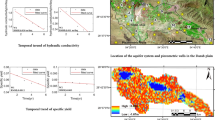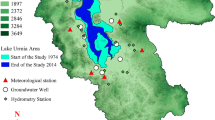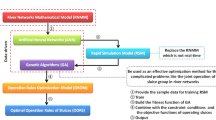Abstract
How to solve the pollution problem of water environment in river network is a hot issue in the world. Artificial floating island is an efficient way to deal with water pollution. Taking Jiashan, Zhejiang, China, as an example, Lattice Boltzmann method (LBM) is used to simulate the law of hydrodynamics and pollutant transport in river network. Lattice Boltzmann equations are established in both artificial floating island and non-artificial floating island sections, and the river network boundary is automatically identified. The simulation results have high accuracy and are more suitable for the establishment of complex boundaries. On this basis, combined with the genetic algorithm (GA) module, the location of the artificial floating island is optimized, and the retention ratio of the pollution in optimized layout of artificial floating island is between and 2.4 and 7.2%. The research results of this paper can provide theoretical reference for the selection and location of artificial floating island in practical engineering.








Similar content being viewed by others
Availability of data and materials
All data generated or analyzed during this study are included in this published article (and its supplementary information files).
References
Abaszadeh M, Safavinejad A, Delouei AA, Amiri H (2022b) Analysis of radiative heat transfer in two-dimensional irregular geometries by developed immersed boundary–lattice Boltzmann method. J Quant Spectrosc Radiat Transfer 280:108086
Abaszadeh M, Safavinejad A, Amiri H and Amiri Delouei A (2022b) A direct-forcing IB-LBM implementation for thermal radiation in irregular geometries. J Thermal Anal Calorim 1–13
Aberle J, Järvelä J (2013) Flow resistance of emergent rigid and flexible floodplain vegetation. J Hydraul Res 51(1):33–45
Afra B, Karimnejad S, Delouei AA, Tarokh A (2022) Flow control of two tandem cylinders by a highly flexible filament: Lattice spring IB-LBM. Ocean Eng 250:111025
Asadi A, Moghaddam Nia A, Bakhtiari Enayat B, Alilou H, Ahmadisharaf E, Kimutai Kanda E, Chessum Kipkorir E (2021) An integrated approach for prioritization of river water quality sampling points using modified Sanders, analytic network process, and hydrodynamic modeling. Environ Monit Assess 193(8):1–15
Bai Y, Xuan W (2022) Drag force coefficient of the flexible vegetation root in an artificial floating bed channel. Ecol Eng 179:106619
Bai Y, Zeng Y (2019) Lateral distribution of sediment and phosphorus in a two-stage ditch with partial emergent vegetation on the floodplain. Environ Sci Pollut Res 26(28):29351–29365
Bai Y, Gao J, Zhang T (2019) Numerical simulation of phosphorus release with sediment suspension under hydrodynamic condition in Mochou Lake. China Water 11(2):370
Bai Y, Zeng Y, Li Q (2020) Retaining performance of four types of drainage ditch on phosphorus: field work. J Irrig Drain Eng 146(11):04020034
Bertuzzo E, Muneepeerakul R, Lynch HJ, Fagan WF, Rodriguez-Iturbe I and Rinaldo A (2009) On the geographic range of freshwater fish in river basins. Water Resour Res 45(11)
Campbell Grant EH, Lowe WH, Fagan WF (2007) Living in the branches: population dynamics and ecological processes in dendritic networks. Ecol Lett 10(2):165–175
Chen L, Han L, Tan J, Zhou M, Sun M, Zhang Y, ... and Fan Y (2019) Water environmental capacity calculated based on point and non-point source pollution emission intensity under water quality assurance rates in a tidal river network area. Int J Environ Res Public Health 16(3):428
Chen H, Deng M and Lu J (2020) Study on the purification of TN in different concentration waters by artificial floating bed. IOP Conf Ser: Earth Environ Sci 440(5):052053. IOP Publishing
Costabile P, Costanzo C (2021) A 2D-SWEs framework for efficient catchment-scale simulations: hydrodynamic scaling properties of river networks and implications for non-uniform grids generation. J Hydrol 599:126306
Fagan WF (2002) Connectivity, fragmentation, and extinction risk in dendritic metapopulations. Ecology 83(12):3243–3249
Fan Y, Zheng J, Deng L, Rao W, Zhang Q, Liu T, & Qian X (2022) Spatiotemporal dynamics of microplastics in an urban river network area. Water Res 118116
Follett E, Chamecki M, Nepf H (2016) Evaluation of a random displacement model for predicting particle escape from canopies using a simple eddy diffusivity model. Agric for Meteorol 224:40–48
Garg A, Leung AK, Ng CWW (2015) Transpiration reduction and root distribution functions for a non-crop species Schefflera heptaphylla. Catena 135:78–82
Huai WX, Zhang J, Katul GG, Cheng YG, Tang X, Wang WJ (2019) The structure of turbulent flow through submerged flexible vegetation. J Hydrodyn 31(2):274–292
Huai WX, Li S, Katul GG, Liu MY, Yang ZH (2021) Flow dynamics and sediment transport in vegetated rivers: a review. J Hydrodyn 33(3):400–420
Huang X, Zhao F, Song C, Gao Y, Geng Z, Zhuang P (2017) Effects of stereoscopic artificial floating wetlands on nekton abundance and biomass in the Yangtze Estuary. Chemosphere 183:510–518
Javadi AA, Al-Najjar MM (2007) Finite element modeling of contaminant transport in soils including the effect of chemical reactions. J Hazard Mater 143(3):690–701
Khattak MS, Anwar F, Saeed TU, Sharif M, Sheraz K, Ahmed A (2016) Floodplain mapping using HEC-RAS and ArcGIS: a case study of Kabul River. Arab J Sci Eng 41(4):1375–1390
Kim J, Lee T, Seo D (2017) Algal bloom prediction of the lower Han River, Korea using the EFDC hydrodynamic and water quality model. Ecol Model 366:27–36
Lean DRS (1973) Phosphorus dynamics in lake water. Science 179(4074):678–680
Leung Y, Lee Y, Lam KC, LIn K and Zeng FT (2005) An environmental decision-support system for the management of water pollution in a tidal river network. Int J Geogr Inf Sci 19(4):483–500
Li S, Wang X, Tu J, Qiao B, Li J (2016) Nitrogen removal in an ecological ditch based on an orthogonal test. Water Air Soil Pollut 227(11):1–9
Li J, Hu J, Wu K, Chen Y, Wang L, Zhang X (2017) Analysis of microbiota in rhizosphere, water and gut of grass carp (Ctenopharyngodon idella) in ponds treated with artificial floating beds. Water Environ J 31(4):572–577
Li D, Wei Y, Dong Z, Wang C, Wang C (2021) Quantitative study on the early warning indexes of conventional sudden water pollution in a plain river network. J Clean Prod 303:127067
Li RM, Shen HW (1973) Effect of tall vegetations on flow and sediment. J Hydraul Div 99(hy5)
Liu HF, Zhou JG, Richard B. (2010) Lattice Boltzmann simulations of the transient shallow water flows. Adv Water Resour 33(4):387–396
Liu H, Zhou JG, Burrows R. (2012) Inlet and outlet boundary conditions for the Lattice-Boltzmann modelling of shallow water flows. Prog Comput Fluid Dyn Int J 12 (1):11–18
Liu C, Shan Y, Lei J, Nepf H (2019) Floating treatment islands in series along a channel: The impact of island spacing on the velocity field and estimated mass removal. Adv Water Resour 129:222–231
Mishra S, Kneis D, Berendonk TU, Aubeneau A (2019) Optimum positioning of wastewater treatment plants in a river network: a model-based approach to minimize microbial pollution. Sci Total Environ 691:1310–1319
Mohamad AA (2011) Lattice Boltzmann method: fundamentals and engineering applications with computer codes. Springer Science & Business Media
Mugisha P, Kansiime F, Mucunguzi P, Kateyo E (2007) Wetland vegetation and nutrient retention in Nakivubo and Kirinya wetlands in the Lake Victoria basin of Uganda. Physics Chem Earth Parts a/b/c 32(15–18):1359–1365
Mynett AE (1999) Hydroinformatics and its applications at delft hydraulics. J Hydroinf 1(2):83–102
Nguyen L, Sukias J (2002) Phosphorus fractions and retention in drainage ditch sediments receiving surface runoff and subsurface drainage from agricultural catchments in the north island, new Zealand. Agr Ecosyst Environ 92(1):49–69
Panda RK, Pramanik N, Bala B (2010) Simulation of river stage using artificial neural network and MIKE 11 hydrodynamic model. Comput Geosci 36(6):735–745
Qi Y, Bai Y, Cao X, Li E (2022) The deformation and shear vortex width of flexible vegetation roots in an artificial floating bed channel. Sustainability 14(18):11661
Rao L, Qian J, Ao YH (2014) Influence of artificial ecological floating beds on river hydraulic characteristics. J Hydrodyn 26(3):474–481
Rao L, Wang PF, Lei Y, Wang C (2016) Coupling of the flow field and the purification efficiency in root system region of ecological floating bed under different hydrodynamic conditions. J Hydrodyn 28(6):1049–1057
Sajjadi H, Atashafrooz M, Delouei AA, Wang Y (2021) The effect of indoor heating system location on particle deposition and convection heat transfer: DMRT-LBM. Comput Math Appl 86:90–105
Salinas A, Torres C, Ayala O (2020) A fast and efficient integration of boundary conditions into a unified CUDA Kernel for a shallow water solver lattice Boltzmann Method. Comput Phys Commun 249:107009
Shan YQ, Liu C, Luo MK, Yang KJ (2016) A simple method for estimating bed shear stress in smooth and vegetated compound channels. J Hydrodyn 28(3):497–505
Sharpley AN, Krogstad T, Kleinman PJ, Haggard B (2007) Managing natural processes in drainage ditches for nonpoint source phosphorus control. J Soil Water Conserv 62(4):197–206
Silvan N, Vasander H, Laine J (2004) Vegetation is the main factor in nutrient retention in a constructed wetland buffer. Plant Soil 258(1):179–187
Tanino Y, Nepf HM (2008) Laboratory investigation of mean drag in a random array of rigid, emergent cylinders. J Hydraul Eng 134(1):34–41
Tsaboula A, Menexes G, Papadakis EN, Vryzas Z, Kotopoulou A, Kintzikoglou K, Papadopoulou-Mourkidou E (2019) Assessment and management of pesticide pollution at a river basin level part II: Optimization of pesticide monitoring networks on surface aquatic ecosystems by data analysis methods. Sci Total Environ 653:1612–1622
Wang T, Zhu B, Zhou M (2019) Ecological ditch system for nutrient removal of rural domestic sewage in the hilly area of the central Sichuan Basin, China. J Hydrol 570:839–849
Wang H, Shen Z, Zeng Y, Yan H, Li Y, Yuan W (2021) Connection between anthropogenic water diversion and hydrodynamic condition in plain river network. Water 13(24):3596
White BL, & Nepf HM (2008) A vortex-based model of velocity and shear stress in a partially vegetated shallow channel. Water Resources Res 44(1)
Wu SQ, Tong ZS, Zhou H, Wu XF (2010a) Simulation methods for accumulation patterns floating debris in hydropower stations. Adv Sci Technol Water Resour 30(2):24–28
Wu SQ, Tong ZS, Zhou H and Wu XF (2010b) Simulation methods for accumulation patterns floating debris in hydropower stations. Adv Sci Technol Water Resour 30(2)
Yang JQ, Kerger F, Nepf HM (2015) Estimation of the bed shear stress in vegetated and bare channels with smooth beds. Water Resour Res 51(5):3647–3663
Yu R, Yang R, Zhang C, Špoljar M, Kuczyńska-Kippen N, Sang G (2020) A vine copula-based modeling for identification of multivariate water pollution risk in an interconnected river system network. Water 12(10):2741
Zhang S, Liu Y, Zhang J, Liu Y, Wang Z (2018) Study of the impact of vegetation direction and slope on drag coefficient. Iran J Sci Technol Trans Civ Eng 42(4):381–390
Zhao X, Zhao X, Chen C, Zhang H, Wang L (2022) Ecological floating bed for decontamination of eutrophic water bodies: using alum sludge ceramsite. J Environ Manage 311:114845
Zhou JG (2004) Lattice Boltzmann methods for shallow water flows (Vol. 4). Springer, Berlin
Zhu L, Li Z, Ketola T (2011) Biomass accumulations and nutrient uptake of plants cultivated on artificial floating beds in China’s rural area. Ecol Eng 37(10):1460–1466
Zhu H, Indupriya M, Gadi VK, Sreedeep S, Mei GX and Garg A (2019) Assessment of the coupled effects of vegetation leaf and root characteristics on soil suction: an integrated numerical modeling and probabilistic approach. Acta Geotech 1–9
Funding
Supported by the National Science Foundation for Young Scientists of China (Grant No. 42207099); Scientific research foundation of Zhejiang University of Water Resources and Electric Power (xky2022004), the Natural Science Foundation of Zhejiang Province: LQ21E090003, the Key Technology Research and Development Program of Zhejiang (No. 2021C03019), the National Science Foundation for Young Scientists of China (Grant No.51909233), the key technology development and application demonstration of comprehensive management and resource utilization of cyanobacteria in Taihu Lake Basin (Key R&D funds of Zhejiang Province: 2021C03196), and the Scientific Research Foundation of Zhejiang University of Water Resources and Electric Power.
Author information
Authors and Affiliations
Contributions
Yu Bai analyzed and interpreted the data and was a major contributor in writing the manuscript. Yizhou Xiao, Yiting Qi, Jinlin Qian, Weidong Xuan, Suli Pan, and Guojin Sun performed the calculation of the model. All authors read and approved the final manuscript.
Corresponding author
Ethics declarations
Ethical approval
Not applicable.
Consent to participate
Not applicable.
Consent for publication
Not applicable.
Competing interests
The authors declare no competing interests.
Additional information
Responsible Editor: Marcus Schulz
Publisher's note
Springer Nature remains neutral with regard to jurisdictional claims in published maps and institutional affiliations.
Rights and permissions
Springer Nature or its licensor (e.g. a society or other partner) holds exclusive rights to this article under a publishing agreement with the author(s) or other rightsholder(s); author self-archiving of the accepted manuscript version of this article is solely governed by the terms of such publishing agreement and applicable law.
About this article
Cite this article
Bai, Y., Xiao, Y., Qi, Y. et al. Combining Lattice Boltzmann method and genetic algorithm to optimize the layout of artificial floating islands in river network in China. Environ Sci Pollut Res 30, 22520–22531 (2023). https://doi.org/10.1007/s11356-022-23785-0
Received:
Accepted:
Published:
Issue Date:
DOI: https://doi.org/10.1007/s11356-022-23785-0




